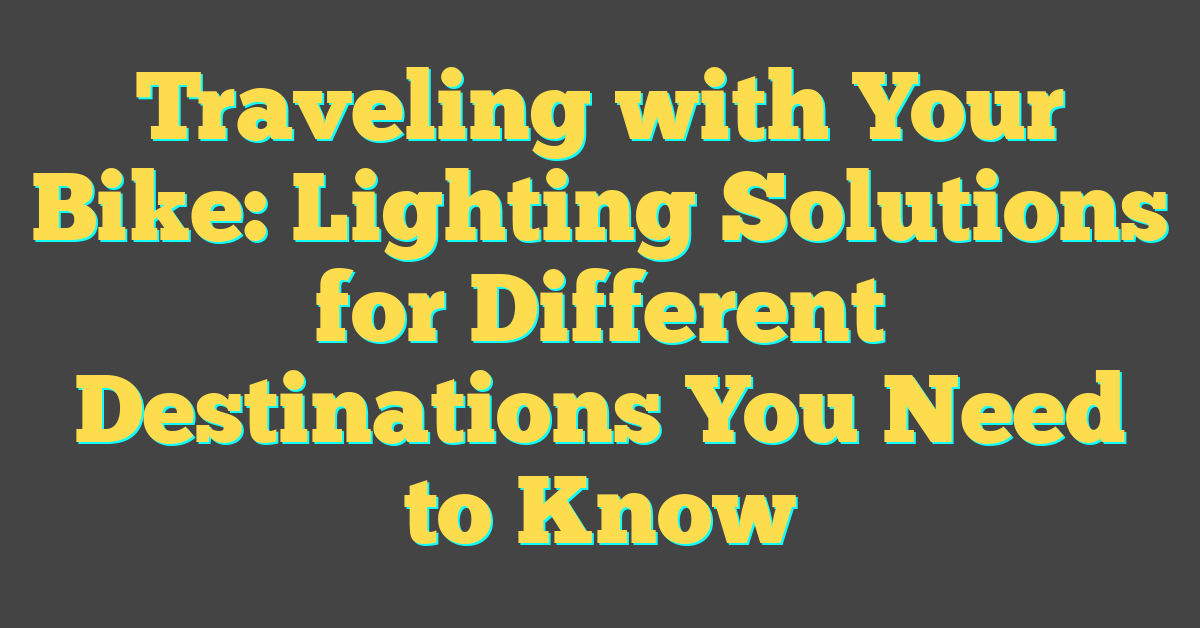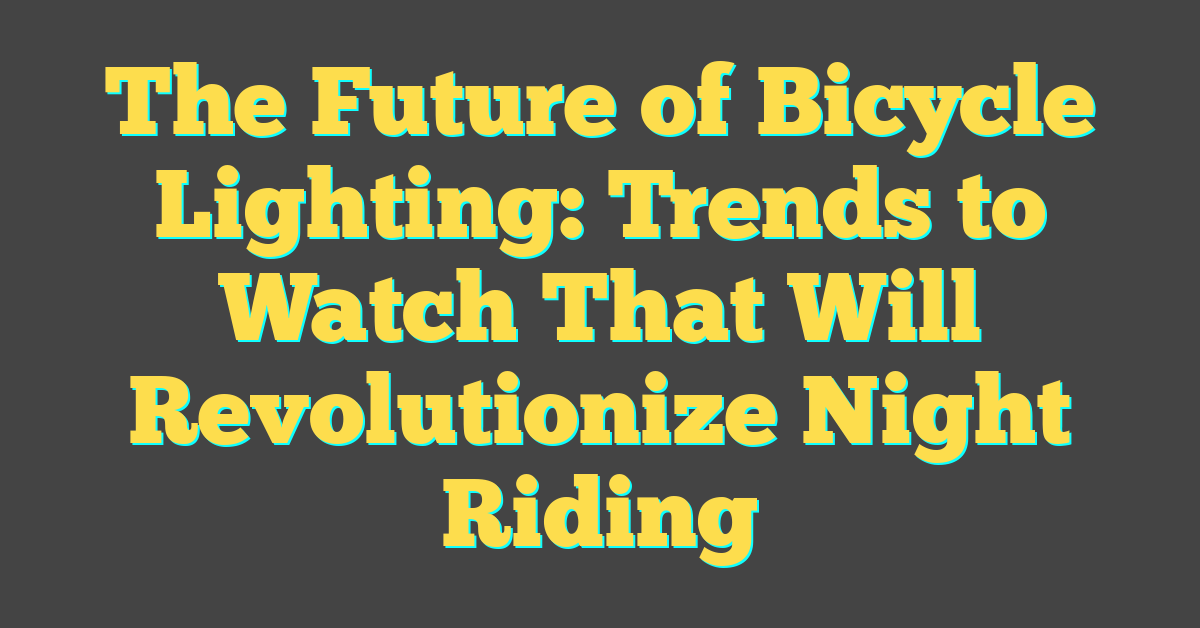Riding through the city at night has a magic all its own. The streets feel quieter, the lights glow brighter, and there’s a sense of freedom that’s hard to match. But let’s be real—cycling after dark comes with its own set of challenges. From navigating traffic to staying visible, it’s not just about hopping on your bike and hoping for the best.

When I first started cycling at night, I quickly learned there’s more to it than meets the eye. With the right gear, a bit of planning, and some street smarts, you can make nighttime rides not only safe but incredibly enjoyable. Whether you’re commuting, exercising, or just exploring, mastering the art of urban cycling at night can open up a whole new world of adventure. Let’s dive into the essentials to help you ride confidently after the sun goes down.
The Importance Of Urban Cycling At Night
Cycling in the city at night reveals a distinct charm that daytime rides don’t offer. The streets seem calmer, the city lights illuminate the surroundings, and there’s a sense of serenity that’s hard to find during the day. As a bike lighting enthusiast, I know firsthand how proper lighting transforms a nighttime urban ride into a safer and more enjoyable experience.
Good lighting ensures you’re visible. City streets at night can conceal cyclists, especially on poorly lit roads or among heavy traffic. A bright white front light and a strong red rear light make all the difference in visibility. I’ve tested countless lighting setups, and I can’t stress enough how essential a dual-light system is for ensuring cars, pedestrians, and other cyclists see you clearly.
Lighting also helps you navigate obstacles. Urban environments present hazards like uneven pavement, potholes, and debris. A well-positioned handlebar-mounted light illuminates these hazards before they become problems. I prefer lights with adjustable beams, as they let you fine-tune the angle based on your riding speed and intensity.
It’s not just about safety; proper lighting adds to the experience. Riding at night with dynamic LED lights or even colorful wheel lights brings creative flair and a personal touch to your bike. I always match my lighting gear with the city’s vibrant energy—it’s both functional and fun.
Investing in quality lights and using them effectively creates confidence during nighttime rides. With bright, reliable lights, exploring urban streets becomes an opportunity to discover the city in a completely new way.
Essential Gear For Nighttime City Cycling
Cycling at night in the city combines excitement with responsibility. The right gear not only boosts confidence but also ensures safety on busy streets during low light. Here’s what I always recommend for nighttime urban rides.
High-Visibility Clothing
Wearing high-visibility clothing amplifies your presence in traffic. Bright colors like neon yellow, green, or orange work best because they catch drivers’ attention quickly. Reflective accents on jackets, gloves, and shoes enhance visibility from different angles. I prefer reflective vests with 360-degree coverage for maximum effect. For added safety, clip-on reflective bands are great for your legs and wrists since their motion makes you more noticeable.
Lights And Reflectors
A reliable dual-light system transforms nighttime cycling into a safer experience. On my bike, I use a front white LED light that produces at least 500 lumens for well-lit streets or 1000 lumens for darker routes. Rear red lights with a pulsing mode create better visibility for drivers. Reflectors mounted on pedals, wheels, and frames are essential as they reflect direct light from vehicles, improving your side visibility.
Dynamic lighting, like wheel-mounted LED light strips, isn’t just about style—it enhances safety as well. I enjoy integrating DIY light projects into my setup, like custom handlebar or under-seat lighting for additional flair and functionality.
Helmets And Protective Equipment
A helmet is a must-have, even more so at night. I recommend helmets with built-in lights or mounts for attaching secondary lighting. I use a model with both, so I can point the light exactly where I’m looking. This is especially helpful on poorly lit paths or for spotting road hazards.
Gloves with padded palms protect against falls and improve grip on damp handlebars. Knee and elbow pads may not be as common among urban cyclists, but I keep them in mind for longer or unfamiliar nighttime routes. Ensuring safety while indulging in my passion for urban cycling is always worth the extra effort.
Tips For Safe Navigation Of City Streets
Cycling in the city at night comes with its own set of challenges and thrills. With the right strategies and awareness, it’s possible to navigate urban streets safely and enjoyably.
Understanding Traffic Behavior
Observing traffic patterns helps predict drivers’ actions. I focus on intersections, where visibility is lower, and ensure I’m visible to turning vehicles. Drivers often misjudge cyclists’ speed, so I use a bright front light to catch their attention and a pulsing rear light for extra emphasis. I also avoid riding in blind spots, especially near buses or trucks.
Planning Your Route Ahead
« Review: Best Reflective Gear for Night Riding – Top Picks to Stay Safe and Visible
Cycling Events in Major Cities: Where Lighting Matters for Safety, Style, and Unforgettable Rides »
Planning routes around well-lit streets and bike-friendly areas reduces risks significantly. I prefer lanes with dedicated bike infrastructure or lower speed limits. Knowing where terrains might have poor lighting or potholes is important. Before nighttime rides, I use online maps with satellite views to check areas for bike lanes or heavy traffic zones, ensuring a smoother journey.
Riding In Bike Lanes And Shared Roads
Sticking to bike lanes promotes safety, but in shared road spaces, staying alert is key. I ride predictably to help cars anticipate my movements and position myself slightly to the left of parked cars to avoid the “door zone.” For streets without bike lanes, I rely on strong, steady beams to light my path forward and reflective accents on my bike for side visibility.
Overcoming Common Night Cycling Challenges
City streets at night hold unique challenges, but proper preparation can turn potential risks into manageable hurdles. From addressing poor lighting to staying safe and alert, each requires thought and the right tools.
Dealing With Poor Lighting Conditions
Poor street lighting can make obstacles, potholes, and even pedestrians harder to see. I rely on a dual-light setup, combining a bright front LED light (at least 500 lumens) for clear visibility and secondary side lights for enhanced peripheral coverage. For darker side streets, I use lights with adjustable beam patterns to focus directly on the path ahead. Reflective tape on my bike frame and wheels creates extra pop under headlights. Staying visible to others matters just as much as seeing the road ahead. Adding dynamic, motion-reactive LED strips to wheel spokes ensures I’m a moving, eye-catching presence.
Addressing Safety Concerns
Navigating late-night city streets demands a proactive approach to safety. I always wear a helmet with built-in LED lights or attachable visibility enhancers for extra protection. In high-traffic zones, I rely on reflective ankle bands and a blinking rear light to keep myself noticeable to drivers and other road users. I remain vigilant at intersections, making deliberate hand signals and maintaining a predictable riding line. Defensive riding in low-visibility conditions is essential, so I position myself away from blind spots and ensure my lights are visible from multiple angles.
Staying Alert And Aware
Night rides mean fewer distractions for me, but staying sharp is still crucial. I use a small mirror mounted on my handlebars to monitor traffic behind me without constant head-turning. Noise-cancelling headphones are a no-go since hearing approaching vehicles or street noise could save valuable seconds in avoiding accidents. My favorite trick is pausing briefly before turning to scan for cyclists and pedestrians who might be harder to spot at night. Adapting my speed to match lighting and road quality ensures I’m ready for sudden changes in my surroundings.
Benefits Of Nighttime Urban Cycling
Cycling through the city at night offers unique advantages that daytime rides just can’t match. Streets are often quieter, with less foot and vehicle traffic, creating a more relaxed environment. This calm makes it easier to enjoy the ride without constant stops or interruptions from congested roads.
Cooler temperatures in the evening provide a refreshing experience, especially during warmer months. I find this particularly enjoyable, as it keeps the ride more comfortable while avoiding the heat of the day. The air feels cleaner, and the overall atmosphere is far more peaceful.
City lights transform the urban landscape into a vibrant and almost cinematic scene. Reflective surfaces, neon signs, and shadows from skyscrapers offer breathtaking views. As someone who loves working with lights, I’m always amazed by how the interplay of natural darkness and artificial illumination enhances the visual experience of a nighttime ride.
Night cycling provides a great opportunity to improve visibility through lighting creativity. I enjoy experimenting with LED systems, reflective wheel accents, and illuminated clothing. These not only make rides safer by catching the attention of drivers and pedestrians but also add a personal touch to my setup. This fusion of functionality and artistry is one of my favorite aspects of cycling after dark.
Greater focus is another undeniable benefit. Without the usual distractions of bustling daytime streets, it’s easier to concentrate on pedaling and maintaining a rhythm. I often use this time to fine-tune my bike’s performance, as the quiet roads allow me to experiment with different riding techniques and adjustments. This reflects my passion for working on bikes and always aiming for the smoothest ride possible.
Conclusion
Nighttime urban cycling offers a unique blend of tranquility and excitement that’s hard to replicate. With the right preparation and a focus on safety, it becomes an adventure filled with glowing cityscapes and peaceful streets.
Investing in quality gear and planning your routes carefully can transform your rides into truly enjoyable experiences. It’s all about staying visible, being predictable, and embracing the magic of the night.
Whether you’re drawn to the quiet or the thrill of exploring your city after dark, cycling at night has a charm all its own. So gear up, stay safe, and enjoy the ride!




